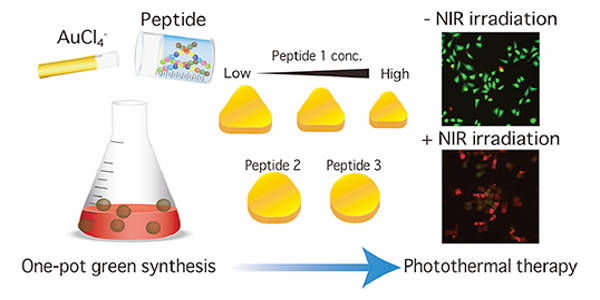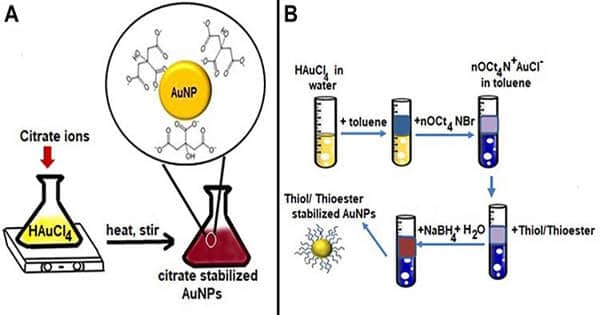Using a biomolecule called B3 peptide, scientists at the Tokyo Institute of Technology (Tokyo Tech) developed an eco-friendly protocol for synthesizing gold nanoparticles with optimized morphology for near-infrared light absorption. They report the synthesis of triangular and circular gold nanoplates and their effectiveness in killing cancer cells by converting absorbed light into heat in their paper, providing useful insights for the development of non-invasive cancer therapy.
The ability of a cancer therapy approach to preserve non-cancerous cells determines its effectiveness. Simply put, the more collateral damage there is, the more severe the side effects of therapy are. Only cancer cells can be targeted and destroyed in an ideal situation. Photothermal therapy, a minimally invasive approach in which cancer cells infused with gold nanoparticles are heated and destroyed using near-infrared (NIR) light that is strongly absorbed by the gold nanoparticles, has emerged as a promising strategy in this regard.
Scientists at Tokyo Tech have designed an eco-friendly protocol for synthesizing gold nanoparticles with optimized morphology for near-infrared light absorption using a biomolecule called B3 peptide.
“Because NIR light can penetrate biological tissues, it can illuminate gold nanoparticles within the body and convert them into nano-sized cell heating agents,” explains Prof. Masayoshi Tanaka of the Tokyo Institute of Technology (Tokyo Tech), Japan, who studies nanomaterials for biomedical applications.
Because of their efficient absorption of NIR light, gold nanoplates (AuNPls) are particularly appealing as photothermal therapeutic agents. However, the process of creating these nanoparticles is hazardous due to the use of harsh reagents and highly toxic conditions. Prof. Tanaka and his collaborators from the United Kingdom (University of Leeds) and Korea (Chung-Ang University) have now addressed this issue in a new study, the results of which have been published in ACTA Biomaterialia.
Gold nanoparticles have numerous applications, including medicine, food processing, water purification, and biological applications. Gold nanoparticles, in particular, are used in drug delivery, photothermal therapy, imaging, sensing, catalysis, and even antimicrobials.

Gold nanoparticles are gold particles with diameters ranging from 1 to 100 nm. They are typically used colloidally. Gold has a tunable bandgap as a quantum dot, which can be controlled by varying the size and diameter of the quantum dots. It has the SPR property, which makes it an appealing choice for dopants in photovoltaic cells.
The idea came from a process known as “biomineralization,” which uses biomolecules to create metal nanoparticles with tunable structures. Because of their small size and stability, peptides, or short chains of amino acids, are particularly appealing candidates for this purpose. However, their use for producing Au nanoparticles with optimized structures for efficient NIR absorption has not yet been reported,” says Prof. Tanaka.
Motivated, the team began by identifying peptides suitable for the mineralization of AuNPls and, after identifying over 100 peptides, decided to investigate the potential of a peptide called B3 for synthesizing AuNPls with a controllable structure that can act as photothermal conversion agents.
In a process known as “one-pot synthesis,” the researchers combined a gold salt, HAuCl4, with B3 peptide and its derivatives at various concentrations in a buffer solution (an aqueous solution resistant to pH changes) at neutral pH and synthesized triangular and circular-shaped AuNPls with varying levels of NIR absorption depending on the peptide concentration.
The team then tested the AuNPls on cultured cancer cells under irradiated conditions and discovered that they had the desired therapeutic effects. Furthermore, when they used B3 derivatives to characterize the peptide, they discovered that an amino acid called histidine governed the structure of the AuNPls.
“Not only do these findings provide an easy and green synthetic method for AuNPls, but they also provide insight into the regulation of peptide-based nanoparticle synthesis,” Prof. Tanaka exclaims. “This could pave the way for new techniques for non-toxic nanoparticle therapeutic agent synthesis.” We may have struck gold with gold nanoparticles!
















